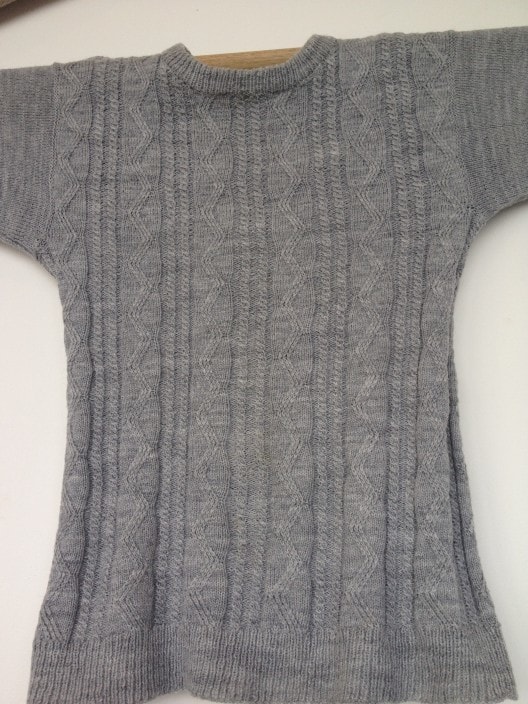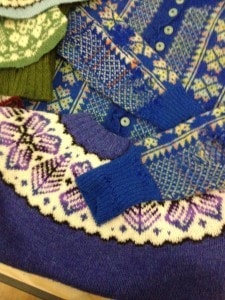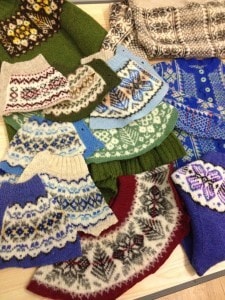Last night the Shetland Museum and Archives hosted an evening of talks for Shetland Wool Week featuring Wool Week patron Hazel Tindall and visiting tutor Stella Ruhe. Dr Carol Christiansen, textile curator at the museum, introduced the speakers noting that both Hazel and Stella had a long relationship with knitting; first knitting for a living and then evolving into working in wider aspects of the industry which cultivated a great passion for knitting and knitting heritage. That passion was exceedingly clear to see when Stella took to the lectern and gave her talk on her research into Dutch traditional ganseys.
It was while working as a textile editor for Cantecleer, in the mid 80s, when she first became interested in traditional fishermen sweaters and oversaw publication of the book Knitting from the Netherlands, by Henriette Van Der Klift-Tellegen. Some decades later she was asked to consider a book on Dutch ganseys and began researching the tradition. Making contact with several archives in the Netherlands and asking if they had evidence of the gansey tradition, Stella was surprised that – in some areas – the gansey was not thought of as traditional clothing and merely seen as working gear. It was quite boggling to learn that those amazing stitch patterns and unique construction methods were not seen as anything worth remembering and it had fallen out of the collective memory. Thanks to wider research though, Stella began to uncover photographic evidence of stunning examples of local gansey patterns, which she had knitters test and recreate for her book, Dutch Traditional Ganseys.
I was wondering how she would approach the old chestnut that you could identify a drowned sailor by the patterns on his gansey. Stella explained that in many of the smaller and more rural fishing communities the stitch patterns may have been kept to a small selection of patterns, which would have been passed on through the generations. Larger communities though were able to access wider patterns and did not stick to a small repertoire, which may have been recognisable as belonging to an area. When you add to this to the fact that many Dutch fisherman bought and traded for (smuggling home) English and Scottish ganseys, when following the herring, and the trend of some fishermen to show their wealth by buying machine-knit sweaters, then the myth falls slightly flat!
It was really interesting to see all the different stitch patterns used – all knit and purl stitches, but used to create something very intricately patterned. The different stitches could represent religion, the weather, the sea, nets and other aspects of life on the boat and, of course, the knitter may have knitted hearts or ‘marriage lines’ into her garment to show that the wearer was spoken for! Before the talk yesterday I took a wander through the Moray Firth Gansey exhibition, which is visiting Shetland for Wool Week; the wealth of patterns is indeed stunning as is the construction; 5 ply yarn knitted on thin needles to create a thick, warm fabric – not waterproof – but quick to dry and trapping in body heat to keep the wearer warm.  There was a disgusted gasp in the audience when Stella explained that most fishermen worked and slept in the sweaters, which made them dirty and greasy. This grease lended itself to making the gansey even sturdier and impervious to the elements. Many fishermen had two ganseys; a good one for Sundays (probably machine made) and one for work. When the Sunday gansey became less than presentable it became the work gansey. When the work gansey became too worn for fishing it became a deck mop – no wonder there is no memory of ganseys being a traditional garment in some areas of the Netherlands!
There was a disgusted gasp in the audience when Stella explained that most fishermen worked and slept in the sweaters, which made them dirty and greasy. This grease lended itself to making the gansey even sturdier and impervious to the elements. Many fishermen had two ganseys; a good one for Sundays (probably machine made) and one for work. When the Sunday gansey became less than presentable it became the work gansey. When the work gansey became too worn for fishing it became a deck mop – no wonder there is no memory of ganseys being a traditional garment in some areas of the Netherlands!
This was an excellent insight into the traditions of ganseys and Stella’s book is a must for those who love their knitting patterns and their knitting heritage too; it features 60 traditional gansey patterns from 40 Dutch villages and it costs around £17. The good news is that Stella is working on a second book on the subject.


Hazel Tindall’s talk was about Shetland knitting in the 1960s looked at through the example of her own mother, Chrissie Sandison. Chrissie was born in 1917, on a very remote croft in Shetland. Chrissie’s mother died when she was very young and she was brought by her aunt Ellen, who knitted for a living. Far more interested in reading that knitting, Chrissie was encouraged to “tak her sock” to earn some “klink” and did pick up the needles though, as Hazel noted, it was never a craft that she enjoyed doing. Hard to believe perhaps, when you look at the quality of knitting produced, but this was common amongst so many home knitters at this time – knitting was work, not pleasure.
Chrissie started keeping a diary in 1961 and this is a very fascinating insight into the Shetland knitwear industry at the time, as well as life in Shetland at that time.
In 1961 Chrissie and her husband, Jeemie, were living in a croft house in Weisdale with 4 children and an extended family. The croft was small with two cows and sheep, but there was a lot of work to do to keep the family and croft going – and without mod-cons such as hot water, inside toilets and telephones! With her husband at sea, Chrissie had to knit to supplement the household income and her diary entries show how difficult it was to get items made in time to bring to the merchant, especially the scrutiny they were under; one example shows that she had to take knitted jackets home when they weren’t the right colour.
In 1963 a knitting machine came to the croft, but Hazel said it was more hassle than it was worth, noting that some efforts were less than desirable. Knitting for Chrissie, and also Hazel and her sisters, was mainly hand knitting yokes and attaching these to machine knit bodies; inserting the collar and grafting on cuffs. The buyer could dictate which colours and patterns were more saleable and Hazel said this really took the creativity out of the process.
Knitting was truly a subsistence job and Chrissie was knitting to keep her head above water much of the time.
“Got all lumbers sold at 45 shillings each. Not much cash left, but it’s good to know I have no debts”
45 shillings is about £35 in today’s money – not much for all the time, effort and kempin (striving) to create a garment. Hazel said that making a living this way was often very depressing though this could be countered by the achievement of finishing and selling an item. Encouragement to knit for those low prices must have been hard to muster – I wonder if Chrissie was reminded of her aunty, knitting for “klink”?
As the 1960s wore on more mod-cons made their way into the croft, including an indoor toilet, television and telephone and Dr Christiansen said she was tickled that they had got a television before indoor sanitation!
Hazel ended her presentation talking about her mam in her later years and how Chrissie had wished she had started keeping a diary long before 1961. This culminated in her writing a book, Slyde in the Right Direction, which is sadly out of print (though Hazel said we should ask The Shetland Times to reprint it, if we’d like to read it!), and documents other parts of her life, work and family.
I asked Hazel afterwards what her mam would have thought about wool week and the interest in knitting now, and she said she would have shook her head and smiled.
Both these talks were utterly absorbing and a fascinating insight into knitting heritage and history, with all it’s fond nostalgia and also those difficult times.
Bravo, Shetland Wool Week. This was one of my favourite events (so far!)
: : Further Information : :
Traditional Dutch Ganseys, by Stella Ruhe is available on Amazon
Hazel’s new DVD, The Fine Art of Fair Isle, is available from her website.


The gansey book sounds wonderful. I may have to treat myself. For research purposes you understand. It’s a fascinating topic and still influences knitting today.
I can understand that knitting for work is not the same as knitting for pleasure. There have been times when I’ve almost cried with relief that a commission had finished!
Thank you for sharing what sounds like a wonderfully, interesting evening.
Thanks for sharing this information. I love history and knitting so it was fascinating to read about both. Although I must admit my knitter’s heart skipped a beat when I read about gansey sweaters being used as boat rags.
Thanks for sharing the event. Such great insights on knitting history and women. I’m anxiously awaiting your next podcast reporting on the rest of your experiences at Wool Week.
Fascinating! Great post, sad that the Shetland knitters probably mostly didn’t enjoy knitting, but totally understandable. We’re so lucky today. Thanks for sharing x
It’s interesting that even back then the difference between what a knitted item is sold for and the actual cost in it being made including time and materials was still out of step. Interesting reading about Dutch ganseys.
Thanks for a great post. I’m intrigued by the Dutch Ganseys, may have to pop over to Amazon, but also Hazel’s recollections. They reminded me of my mum telling me of how her mum knitted riding gloves in yellow nobbly cotton yarn for members of the local hunt and for sale to a broker in the local town. I inherited some of that yarn in my Gran’s worktable and it’s horrible to work with. My mum was given the job of knitting the ribbed cuffs only because as a young and inexperienced knitter she couldn’t be risked with the more complicated elements of the pattern. They had to be done perfectly first time for sale, mistakes were literally costly. This would have been in the 1950s and the glove money would have been the only supplement to my Gran’s war widows pension. However, when mum told me how much they got per pair, which I have written down somewhere, I could certainly see what a chore it must have been to be reliant on so little for so much time and work. I only hope my Gran enjoyed knitting the clothes she knitted for us as kids more than she did the gloves. I know I wore my knits with pride, but luckily I grew up in a rural area with no concept of fashion until I was much older!
My weaving teacher and long time friend, Norman Kennedy was raised in Aberdeen in the 1930’s and he traveled all over Scotland as a tax collector in he late 50’s. He has often told me about a woman he knew in the western isles who was a great singer. She said she had learned many of her songs from the days spent following her mother up and down the beach as she wept and sang after receiving the news that her husband and brothers had all been lost in a fishing boat that went down. Eventually the bodies were found and the mother identified her husbands body not by the pattern of his Gansey but by the mended area she had recently stitched.
[…] became aware of the Cornish Gansey Company earlier this year. I am a big fan of the gansey; I have written about it before on here, and was lucky enough to see the Moray Firth Gansey exhibit last year. What I really love about […]